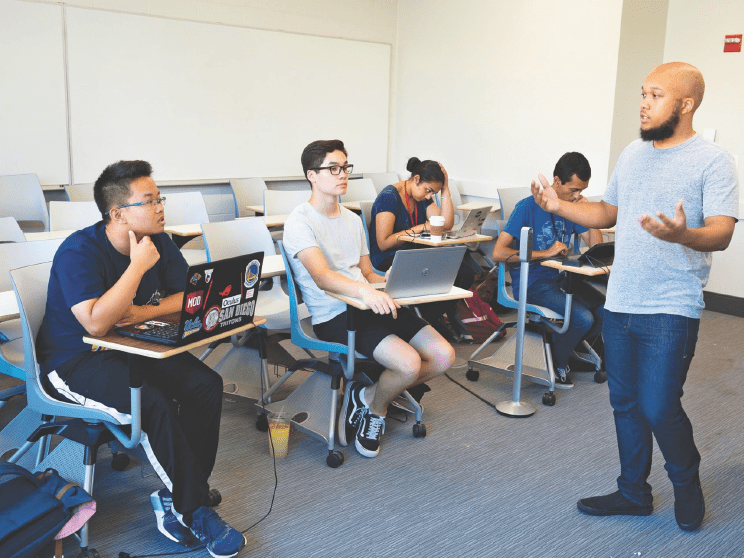Cindy Rogel Bahena, a senior majoring in materials science and engineering, was thrilled to receive a full-ride scholarship to ASU in order to pursue a career as an electrical engineer.
As a first-generation Mexican-American college student and the oldest of seven siblings, working hard for her career would set an example for the rest of her family.
However, working toward that degree was anything but easy once Bahena arrived on campus. Even with financial assistance, she had to work two jobs a semester, not only to put herself through college, but to help her parents with financial hardships — even prior to the pandemic.
While studying a field in STEM, a complex program of study that combines science, technology, engineering and mathematics into one domain, Bahena and other first-generation students see firsthand the large socioeconomic gap.
A 2019 study by the National Student Clearinghouse Research Center found that only half the number of graduates from low-income schools completed a STEM degree compared to graduates from higher-income schools within six years after high school.
Lack of preparation, finding aid
Prior to college, Bahena said she “didn’t know anything about engineering and STEM.”
“I liked science and math, but my high school didn’t have the best science program,” Bahena said. Many of her teachers didn’t stay at the school long before leaving, so she “didn’t really have a solid basis,” she said.
It wasn’t until she attended ASU’s summer camps before college when she slowly became interested, because a lot of her tutors were engineers.
Bahena said that applying to colleges was very difficult for someone like her, given her family’s economic status. But educating parents about scholarships for lower-income students like her can help alleviate these financial stresses.
“A lot of parents think they can’t take their children to college because it’s very expensive,” Bahena said. “In reality, because of our lower economic status, we can get a lot of grants and scholarships.”
In President Joe Biden’s “plan for education beyond high school,” the Biden Administration intends to alleviate financial burden by making college more affordable. This plan will provide “hard-working students” two years of community college tuition free. The plan also looks to invest $5 billion in graduate programs in teaching, healthcare and STEM.
In Biden’s campaign, he also advocated for a program that would offer up to $10,000 in federal student loan debt.
Sara Brownell, an associate professor in the School of Life Sciences, said any plans to make college more affordable will surely have a positive impact. Brownell is also the director of the Research for Inclusive STEM Education Center, an initiative that aims to make STEM more inclusive by identifying inequities in classrooms.
Brownell affirms that a large portion of funding for public institutions like ASU used to be state-subsidized, but that has since changed.
“Over the years, far less of that (money) is supported by the state, and the individual student and their family is expected to take on that responsibility of paying for college,” Brownell said.
Kristen Parrish, associate director of the RISE Center at ASU and an associate professor in the School of Sustainable Engineering and the Built Environment, said she believes increased financial aid and support on a federal level could help grow the pipeline of people interested in and prepared for a career in STEM, depending on what the transfer process looks like for a community college student.
“It’s important to make sure that the articulation pathways from community colleges into universities are well done,” Parrish said. “I think that would revolutionize who feels they can access college and be successful.”
Also Read: SU program helps younger Onondaga County students advance in the STEM field
Also Read: New course empowers students to address diversity in STEM
Barriers beyond financial
Still, Parrish said there is still a long way to go in terms of representation, often leaving marginalized groups behind.
“Everyone’s identities are intersectional, and bringing them all to the table is what allows us to have exciting conversations … and different perspectives,” Parrish said. “STEM classrooms traditionally have not been set up to cultivate that.”
READ MORE: ‘Identities matter’: The Polytechnic School’s gender equality equation
The RISE Center found that inclusive environments were a major reason as to why marginalized students didn’t complete STEM programs at ASU, rather than a lack of interest.
Parrish explains that being the only low-income student, women of color or any number of identities within a classroom has, “got to be exhausting.”
“If a student is bravely taking on a major that no one in their family has ever pursued before, it is immediately going to be harder,” Parrish said.
That is true for Bahena, who persists through that reality to be a role model for her younger siblings — some of them are already starting to show an interest in STEM — and other first-generation students.
“Students don’t give themselves enough credit, and we don’t quantify our accomplishments,” Bahena said.
Courtesy: State Press
